Table of contents
- PS-Technik series part 6 Primary drive and clutch
- Simple but robust spur gears
- Crank web designed as a gear at the same time
- Two cylinders thrash on the gears
- Almost no splash losses with modern sports engines
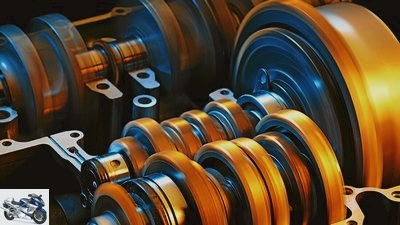
fact
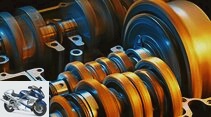
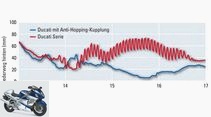
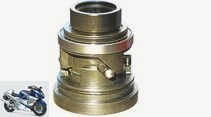
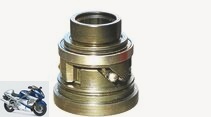
16 pictures
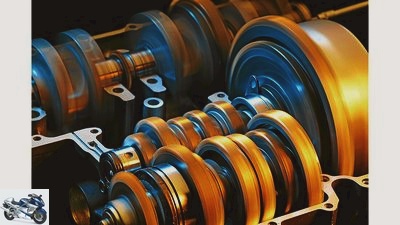
archive
1/16
The primary drive and clutch shovel the mountains of torque from the crankshaft to the gearbox. A task that can only be mastered with clever tricks.
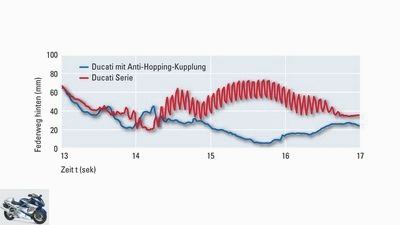
Cook
2/16
Spring movement on the rear wheel compared when braking and downshifting. Without an AHK (red) the rear wheel loses contact with the ground with 16 vibrations per second and pulls itself upwards through the rebound damping. With a towbar (blue), the bike rebounds the bumps cleanly and can transfer sufficient grip when turning.
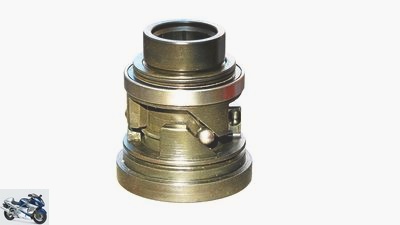
Cook
3/16
AHK function 2: If the braking torque of the motor works in the opposite direction to the drive direction, the upper part of the clutch hub pushes upwards over the ramps and counteracts the force of the clutch springs. As a result, the clutch slips through and reduces the braking torque and the tendency to punch.
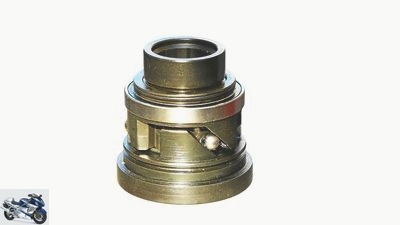
Cook
4/16
AHK function 1: The mechanical slipper clutch has no effect under load, i.e. when the two ramps are loaded in the same direction. The balls run in guides, reduce the friction of the ramps and thus make the lifting of the pressure plate against the spring force more flexible.
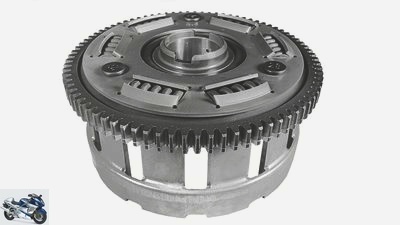
Bilski
5/16
Spring dampers on the clutch basket dampen the torque peaks of the engine in a torsional movement.
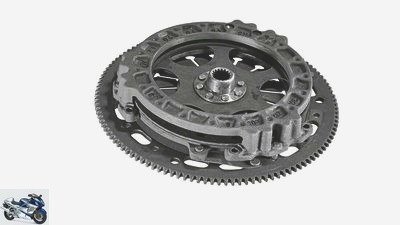
Bilski
6/16
Single-disc clutch: very similar to the car systems, this sits between the engine housing and the gearbox in BMW boxers (but not in the new GS) and Moto Guzzi engines.
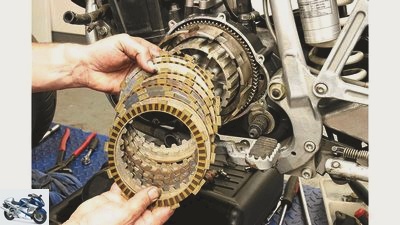
Schermer Verlag
7/16
Clutch friction plates should be marked before dismantling so that they can be reinstalled in exactly the same position and the drivers are evenly in contact with the clutch basket.
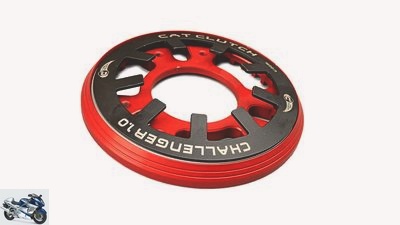
archive
8/16
Disk springs press the clutch disks together. With the right design, lower operating forces are possible with the same contact pressure compared to helical springs.
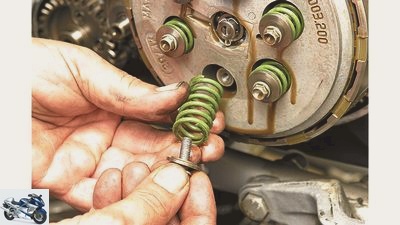
Schermer Verlag
9/16
In most clutches, coil springs compress the package of steel and friction disks. They can be varied in strength and preload depending on the engine torque.
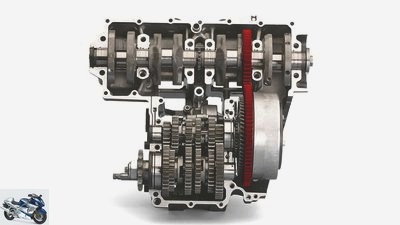
fact
10/16
Gear primary drive: Used on almost all modern four-cylinder in-line engines. A crank web is designed as a gear that acts directly on the clutch.
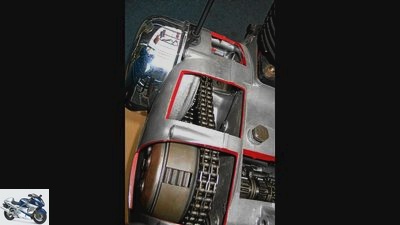
Cook
11/16
Duplex chain: was installed on many machines up until the 1960s. Advantage: Simple chain change, which was also necessary due to the poor quality.
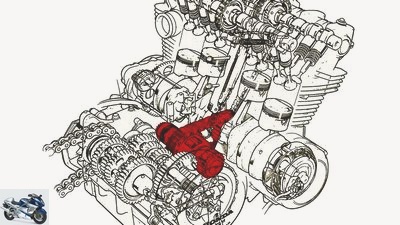
archive
12/16
Toothed chain: Leads to the countershaft with integrated shock absorber (red), which reverses the direction of rotation in front of the clutch. Elaborate but soft power transmission.
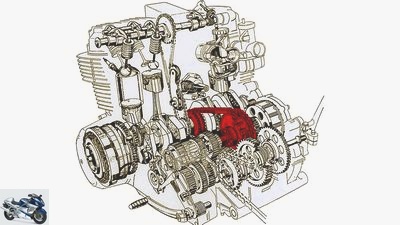
archive
13/16
Duplex roller chain: Due to the constant direction of rotation on the primary drive (red), this must be reversed by using an elaborate three-shaft gear.
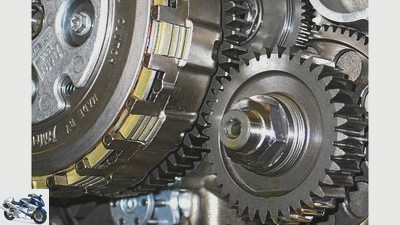
Cook
14/16
Straight toothed primary drive. Provides direct power transmission without side forces. Since only one tooth is in mesh, it is subject to greater stress and can generate running noises.
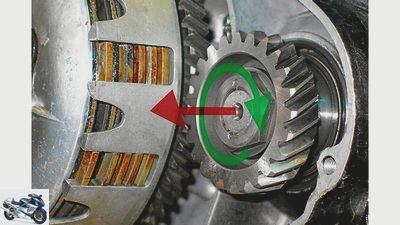
Cook
15/16
Helical-toothed primary drive. This runs quietly and can transmit a lot of torque because several teeth are in mesh. The resulting side forces (red arrow) cost performance.
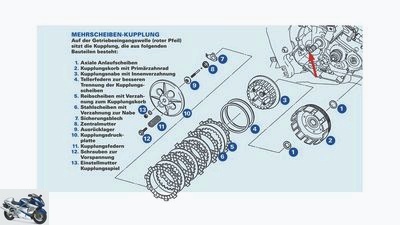
Schermer Verlag
16/16
Multi-disc clutch.
counselor
workshop
Primary drive clutch
PS-Technik series part 6
Primary drive and clutch
Content of
The primary drive and clutch shovel the mountains of torque from the crankshaft to the gearbox. A task that can only be mastered with clever tricks.
Werner Koch
09/17/2013
When designing the primary drive, the manufacturers chose different approaches. Before the great motorcycle boom in the early 1970s, duplex or even triplex roller chains were often used, which were installed directly between the crankshaft and clutch. These chain drives running in the oil bath were not always completely trouble-free – some chipped rollers were found in the oil sump – but had the advantage of good self-damping and could be exchanged quickly and inexpensively.
Buy complete article
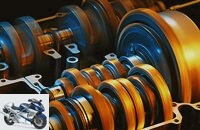
PS-Technik series part 6
Primary drive and clutch
6 pages) as PDF
€ 2.00
Buy now
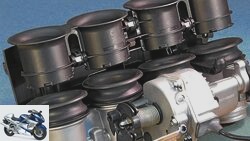
workshop
PS technology special
Further training for motorcyclists
read more
Simple but robust spur gears
Another solution for the primary drive – it reduces the speed to the same extent as it increases the effective torque – are simple but robust spur gears. They are still used in almost all modern single and two-cylinder engines to this day. In order not to excessively strain the tooth flanks with the small gear wheel diameters, helically toothed primary drives were built until the end of the 1970s.
The advantages: The teeth, which are arranged at an angle of around 20 degrees, engage more continuously, run quietly and can transmit more torque than straight-toothed designs with the same size. The disadvantage: When force is applied to the inclined tooth flanks, lateral forces arise, which is why crankshafts and gear shafts in such motors have to absorb axial forces that lead to slight friction losses. Since the helical gearing is also more expensive to manufacture, straight-toothed and larger-sized drives are predominantly used today. The disadvantage of the higher noise development is often compensated for by the trick with preloaded, two-part gears. These ensure that the backlash, i.e. the distance between the teeth of two intermeshing gears, is reduced to almost zero under all circumstances – cold engine, hot engine, load or coasting operation.
Crank web designed as a gear at the same time
With the first modern large-scale four-cylinder engine, the technicians had to come up with a solution that harmonized the large overall width of the engine with the relatively narrow five-speed claw transmission. Simply transferring the power from the crankshaft stub to the clutch was no longer possible. In order to reverse the direction of travel of the crankshaft, which usually rotates forwards to the gearbox output, the crankshaft was coupled with an additional countershaft using a toothed chain (see sectional drawing in the picture gallery). In contrast to a gear primary drive, in which the direction of rotation is reversed, in a chain both shafts rotate in the same direction.
This problem was solved when the four-cylinder engines started to design one of the middle crank webs as a gear at the same time (photo in the picture gallery), which dramatically reduced the mechanical effort. Because with a compact and light drive with two-shaft gear, the direction of rotation only has to be reversed once (crankshaft forward, input gear shaft backward, output gear shaft / pinion forward). No wonder that this principle, which Kawasaki already applied in 1972 in the legendary 900 Z1, has firmly established itself in multi-cylinder in-line engines.
The solution of the shock absorber in the gearwheel of the clutch basket has also become firmly established (photo in the picture gallery). This is rotatably mounted on the hub and is supported on coil springs or rubber bearings on the basket. Every hard torque peak that the motor chases into the drive causes the clutch basket to reduce this force peak against the spring pressure. In addition, a slight slip (up to 100 crankshaft revolutions per minute at maximum working pressure) in the clutch dampens the peaks of the drive forces. Only in this way can the primary drive and gear wheels survive the attacks of the internal combustion engine over tens of thousands of kilometers.
Two cylinders thrash on the gears
And why all the effort? Because the engine output is not a smoothly ironed torque band, but rather a mountain with enormous torque peaks, the primary drive and clutch have to appease the hammering hammer mechanism. If the relatively uniform four-cylinder sports engines are gentle, the two-cylinders of a Ducati or KTM thrash the gears, tug and bend the clutch and transmission shafts with brutal torque peaks. The reason for the extreme load: While the torque of the combustion stroke acts on the drive evenly after every half crankshaft revolution with a four-cylinder, a two-cylinder hammer with almost twice the force on the crankshaft, after which, due to the gas exchange (intake and compression), really slow down and gain momentum with the next work cycle. This irregular engine running builds up enormous loads in the drive train, especially at low and medium speeds.
And it is precisely these fluctuations in torque that trigger a completely different problem, especially with sports motorcycles: the rear wheel jarring when braking and downshifting at the same time. With the so-called anti-hopping clutches, AHK for short, the excessive braking torque of the engine is reduced, the rear wheel maintains contact with the road, and the motorcycle can be turned cleanly and safely. As soon as the braking effect of the engine exceeds a certain level, a simple mechanism consisting of ramps and counter ramps pushes the clutch disks apart against the pressure of the springs (see photo gallery for photos). To the extent that the clutch slips easily, but the motor still has a sufficient braking effect on the rear wheel without it starting to jump. The angle of the ramps is determined depending on the motor design and the corresponding braking torque. Flat ramps release the clutch earlier and more sensitively than steep ramps. In order to reduce the friction in the system, the ramps on many AHK racing clutches work with rollers or balls. AHKs can be used with both wet and dry clutches. The wet clutch, also known as an oil bath clutch, is the most common and has long since replaced the rattling dry clutch even in super sports engines.
The advantages of the oil bath clutch: Better controllability thanks to the engine oil introduced via the gear shaft, which also cools the clutch and prevents overheating during full-load starts. The friction disks are usually made of an organic material that is more heat-sensitive than sintered metal, but does not have any destructive effects on the bearing points in the engine.
Almost no splash losses with modern sports engines
Due to the clutch basket, which is positioned well above the oil level, modern sports engines have almost no slipping losses (= resistance of components that rotate or oscillate in the oil bath). In order to guarantee optimal release of the oil bath clutch when the engine oil is cold and viscous, the release travel of the clutch package (technical jargon: lift) is calculated at around 0.2 to 0.3 millimeters per friction disk should avoid the coupling with oil.
Special designs are the single or double-disc dry clutches, which are used, for example, in the BMW boxers (except for the latest version) and the V2 Guzzi engines.
Related articles
-
Honda patent: all-wheel drive to generate electricity
Honda 3 pictures Honda 1/3 Honda is probably planning to use front-wheel drive to increase the potential of generating braking energy in electric drives….
-
Technical question about clutch discs made of aluminum
Cook counselor technology & future Technical question about clutch discs made of aluminum Technology question – what use are clutch friction plates made…
-
Honda patent new sports clutch: Clutch-by-Wire
Honda 8th pictures Honda 1/8 Honda’s invention addresses the technical compromise of the anti-hopping clutch and adds a semi-automatic system to the…
-
How to change the clutch on your motorcycle
counselor workshop How to change the clutch on your motorcycle Workshop: clutch change, part 1 How to change the clutch on your motorcycle Engage first…
-
counselor technology & future Technology: belt drive technology Belt drive Full automation instead of full employment, just step on the gas instead of…
-
Rekluse clutches: When the clutch becomes automatic
Extra cross counselor technology & future Rekluse clutches: When the clutch becomes automatic Rekluse clutches When the clutch becomes automatic The…
-
Ducati Pro-I Evo: A Duc with electric drive
Ducati 7th pictures Ducati 1/7 With the Pro-I Evo, Ducati is bringing a model with an electric drive. Ducati 2/7 The foldable e-scooter has a weight of…
-
Michelin patent: friction wheel drive as a maneuvering aid
Michelin 6th pictures Michelin 1/6 Tire manufacturer Michelin has patented an electric maneuvering aid for motorcycles. Michelin 2/6 The compact unit…
-
Dry clutch and oil bath clutch advantages and disadvantages
archive counselor technology & future Dry clutch and oil bath clutch advantages and disadvantages Dry clutch and oil bath clutch advantages and…
-
Brake and clutch levers care and replacement
Schermer counselor workshop Brake and clutch levers care and replacement Workshop: hand lever maintenance and new acquisition Brake and clutch levers…